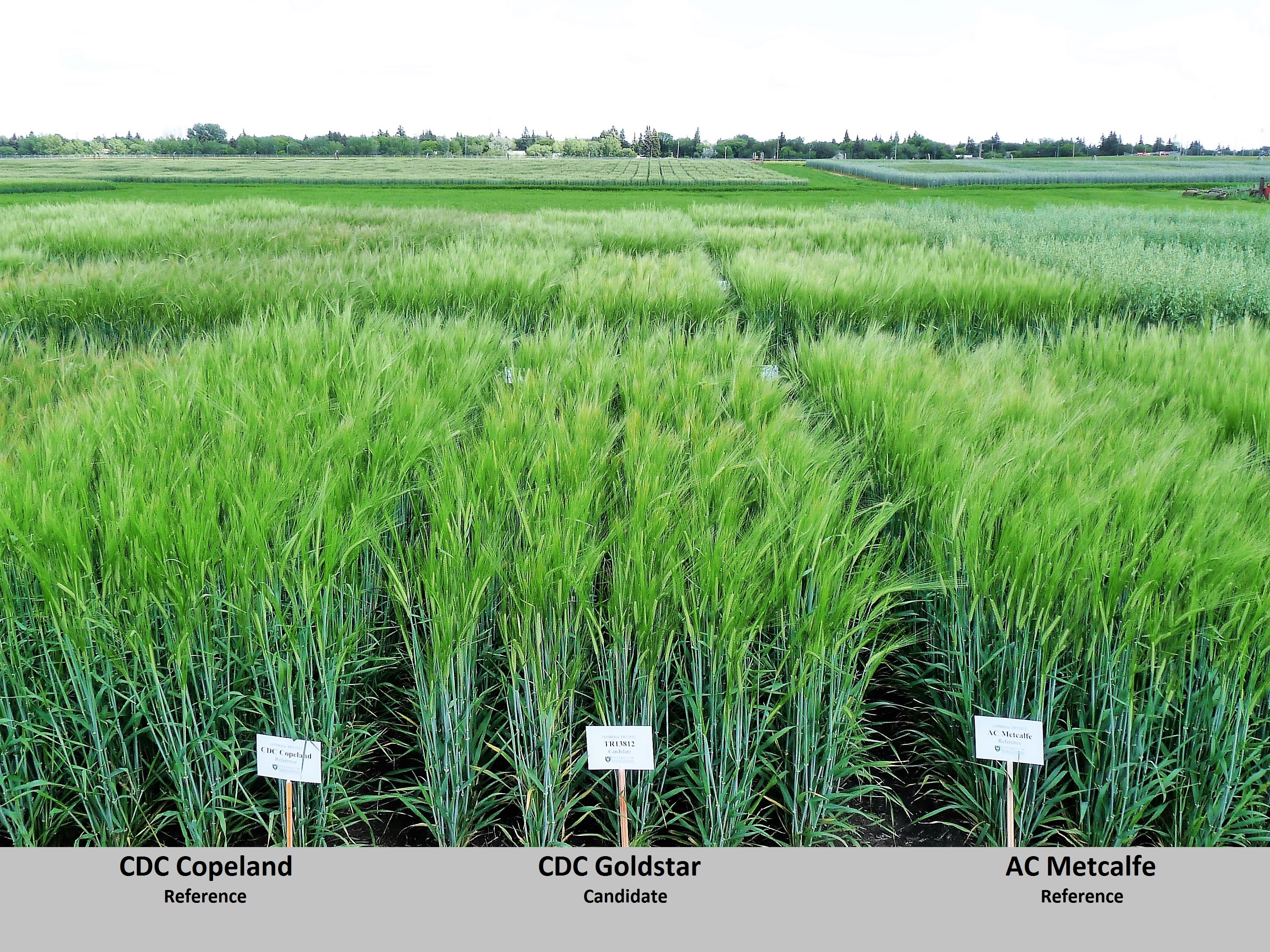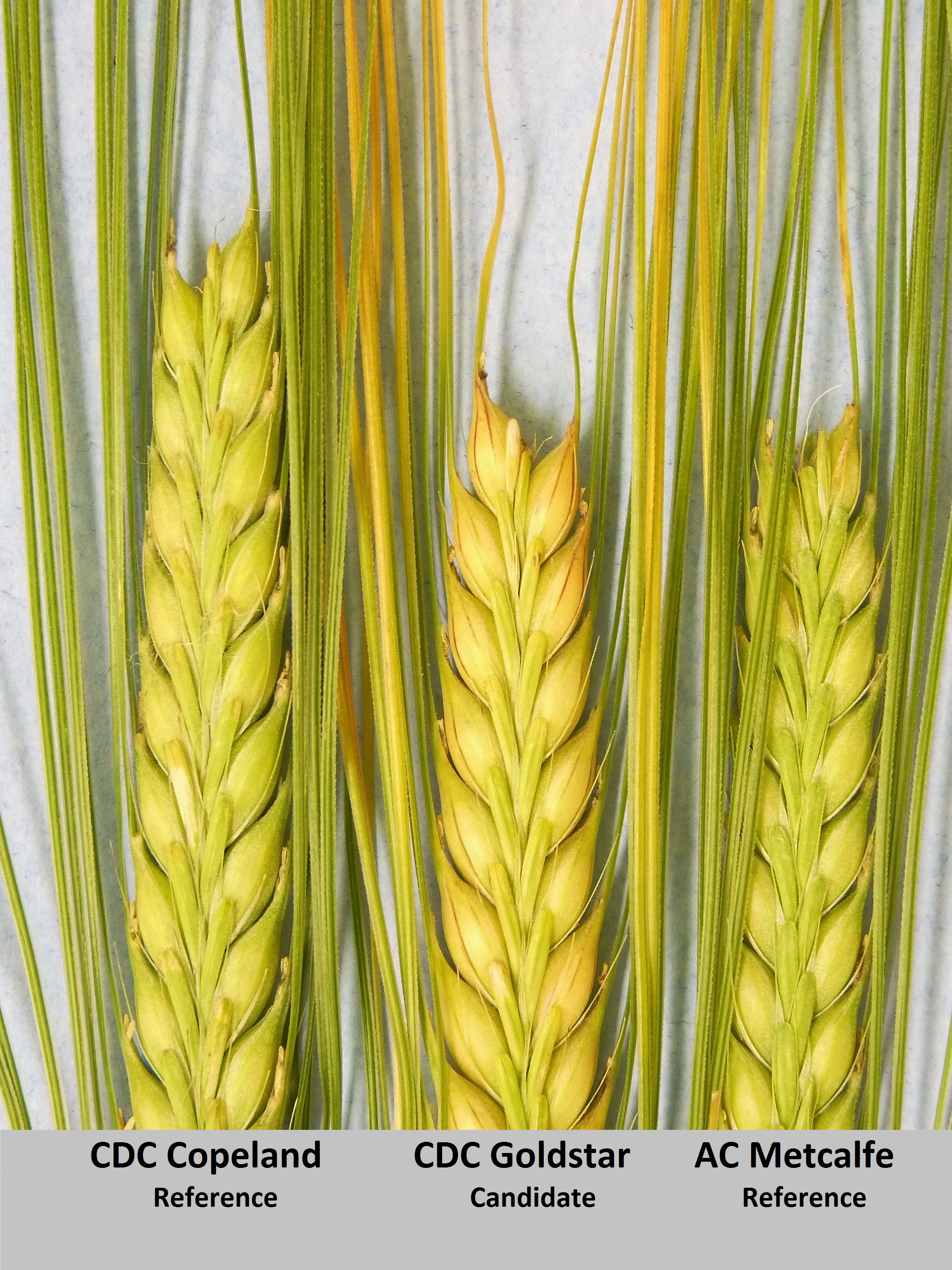CDC Goldstar
| Denomination: | 'CDC Goldstar' |
|---|---|
| Botanical Name: | Hordeum vulgare |
| Applicant/Holder: |
University of Saskatchewan Crop Development Centre 4D36 Agriculture Building, 51 Campus Drive Saskatoon, Saskatchewan S7N 5A8 Canada |
| Breeder: |
Aaron Beattie, University of Saskatchewan, Saskatoon, Saskatchewan |
| Application Date: | 2017-03-21 |
| Provisional Protection:: | 2017-03-21 |
| Application Number: | 17-9139 |
| Grant of Rights Date: | 2018-08-29 |
| Certificate Number: | 5804 |
| Grant of Rights Termination Date: | 2038-08-29 |
Variety Description
Varieties used for comparison: 'CDC Copeland' and 'AC Metcalfe'
Summary: The frequency of plants with recurved flag leaves is low for 'CDC Goldstar' while the frequency is medium for 'CDC Copeland'. The flag leaf is shorter for 'CDC Goldstar' than for 'CDC Copeland'. The plants of 'CDC Goldstar' are shorter than those of 'CDC Copeland'. The spike, excluding awns, is longer for 'CDC Goldstar' than for 'AC Metcalfe'. The intensity of anthocyanin colouration of the nerves of the lemma is weak to medium for 'CDC Goldstar' while it is absent or very weak for 'AC Metcalfe'
Description:
PLANT: two row, spring malting-type, low frequency of plants with recurved flag leaves
YOUNG PLANT (at tillering): intermediate growth habit, absent or very sparse pubescence on lower leaf sheaths
FLAG LEAF BLADE: very weak to weak pubescence at basal area
FLAG LEAF SHEATH: medium glaucosity, absent or very sparse pubescence
AURICLE: medium to strong intensity of anthocyanin colouration, medium pubescence on margin
SPIKE: emerges mid-season, weak to medium glaucosity, semi-erect attitude, predominantly v-shaped collar, tapering to parallel shape, lax density, parallel to weakly divergent attitude of sterile spikelet, glume and awn of median spikelet are equal to length of grain
FIRST SEGMENT OF RACHIS: medium length, weak to medium curvature
LEMMA AWNS: absent or very weak to weak intensity of anthocyanin colouration of tips, longer than length of spike, rough spiculation on margins along entire length
KERNEL: weak to medium intensity of anthocyanin colouration of nerves of lemma at early to soft dough stage, whitish aleurone layer, long rachilla hairs, husk present, absent or very weak spiculation of inner lateral nerves of dorsal side of lemma, no hairiness of ventral furrow, clasping disposition of lodicules, horseshoe and incomplete horseshoe shaped basal markings, medium to long, medium width
AGRONOMY: good resistance to lodging and shattering, good tolerance to straw breakage, fair to good drought tolerance, good malting quality
DISEASE REACTION: resistant to Covered smut (Ustilago hordei)
Origin & Breeding History: 'CDC Goldstar' (experimental designations 'TR13812' and 'SM105054') was developed by Sapporo Breweries in Gumma, Japan and the Crop Developement Centre, University of Saskatchewan, Saskatoon, Saskatchewan. It originated from a cross between 'CDC Reserve' and the F1 seed from the cross, 'TR03375' / 'CDC PlatinumStar', conducted in Gumma, Japan in 2006. The F1 generation was increased as a bulk population in a summer nursery in Hokkaido, Japan in 2006. From 2006 to 2008, the F2 to F4 generations were bulked using contra-season growing methods between Saskatoon, Saskatchewan and New Zealand. The F5 generation was grown in Saskatoon, Saskatchewan as a space planted population in the summer of 2008 and selected spikes grown as F6 hill plots in 2009. The resulting seed was bulk harvested as line 'SM105054' and subsequently tested in the Crop Development Centre yield trials from 2010 to 2012 and in the Western Cooperative Two Row Barley Registration Trials as 'TR13812' during 2013 and 2014. Selection criteria included good agronomic performance, strong straw, grain yield, grain quality and disease resistance.
Tests & Trials: The comparative tests and trials for 'CDC Goldstar' were conducted at the University of Saskatchewan Crop Science Field Laboratory in Saskatoon, Saskatchewan during the 2016 and 2017 growing seasons. The trials were planted in a RCB design and consisted of 4 replicates for each variety. Each plot consisted of 5 rows, 3.66 metres in length, with a row spacing of 0.2 metres. The planting density was 215 plants per square metre. The measured characteristics were based on a minimum of 20 measurements each year. The mean differences were significant to at least a 5% probability level based on a paired Student's t-test.
Comparison tables for 'CDC Goldstar' with reference varieties 'CDC Copeland' and 'AC Metcalfe'
Flag leaf length (cm)
| 'CDC Goldstar' | 'CDC Copeland' | 'AC Metcalfe' | |
|---|---|---|---|
| mean 2016 | 8.88 | 10.87 | 9.12 |
| std. deviation 2016 | 1.16 | 1.56 | 1.14 |
| mean 2017 | 11.92 | 13.25 | 11.89 |
| std. deviation 2017 | 2.52 | 2.86 | 2.50 |
Plant height (including awns) (cm)
| 'CDC Goldstar' | 'CDC Copeland' | 'AC Metcalfe' | |
|---|---|---|---|
| mean 2016 | 74.10 | 81.40 | 74.10 |
| std. deviation 2016 | 3.00 | 2.70 | 2.80 |
| mean 2017 | 88.00 | 94.10 | 88.80 |
| std. deviation 2017 | 4.00 | 4.80 | 4.30 |
Spike length (excluding awns) (cm)
| 'CDC Goldstar' | 'CDC Copeland' | 'AC Metcalfe' | |
|---|---|---|---|
| mean 2016 | 9.14 | 9.45 | 8.35 |
| std. deviation 2016 | 0.86 | 0.84 | 0.74 |
| mean 2017 | 9.94 | 9.26 | 8.51 |
| std. deviation 2017 | 0.83 | 0.86 | 0.78 |
Click on image for larger view

Barley: 'CDC Goldstar' (centre) with reference varieties 'CDC Copeland' (left) and 'AC Metcalfe' (right)
Click on image for larger view

Barley: 'CDC Goldstar' (centre) with reference varieties 'CDC Copeland' (left) and 'AC Metcalfe' (right)
Click on image for larger view

Barley: 'CDC Goldstar' (centre) with reference varieties 'CDC Copeland' (left) and 'AC Metcalfe' (right)
- Date modified: